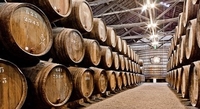The world of Port wine changes slowly, but there have been a few modifications of the long-standing Port offerings we have become accustomed to. If you have not ventured into the world of fine Port, the upcoming autumn months are a perfect time to begin. As the weather gets colder and the days get shorter, we seek heartier beverages to fortify our existence. Indeed, Port became popular as a drink in England because its combination of alcohol and residual sugar provided needed calories in the cold, damp London winters.
Port is a fortified wine. That means that after the grapes are picked, fermentation begins in a normal manner with yeasts consuming the grape sugars and turning them into alcohol. Before the fermentation is complete, however, the process is arrested by the addition of aguardente, a neutral grape brandy that raises the alcohol content while retaining the natural grape sugars of the wine. Port is an important export product for Portugal and there are regulations regarding its production and labeling. It is the responsibility of the Instituto dos Vinhos do Douro e Porto (IVDP) to regulate and monitor many facets of the Port wine industry as well as to promote Port wine throughout the world.
There are many types of Port – Ruby Port, Vintage Port, Late-Bottled Vintage Port, even Rosé Port and others – but we will focus on Tawny Ports for the moment. After fermentation and fortification, the new wine is transferred to oak barrels for aging. Tawny Port gets its name from the tawny color it develops during this long aging process. Tawny Ports are aged before bottling and are not intended for further cellaring.

Even within the Tawny Port category, there are several subdivisions. Most Port houses market a simple, affordably-priced Tawny Port. This “House Tawny” is blended for consistency and is often the most widely-sold Port brand. There are also Reserve Tawny Ports. These are selections of better quality wines that are generally aged 6 years or longer in cask before release. They must pass muster with the IVDP before selling. The Reserve category should exhibit elegant flavors combining youthful fruitiness with signs of maturity.
Tawny Ports with an indication of age are typically produced in a consistent style. Maintenance of the house style is the primary goal of the winemaker and there can be significant differences among houses. Age-designated Tawny Ports are a relatively new item for a centuries-old business. They were first permitted in 1973 and have expanded since that time. The best examples maintain a beautiful acidity that balances the residual sugar. The long barrel age results in wine with a translucent reddish-brown or orange color and a complex, nutty taste.
The IVDP creates standards for Age-dated Tawny Ports which, until recently came in decadal designations of 10, 20, 30, and 40 years. In 2021, the IVDP approved a new category – 50 year old Tawny Port. Those houses with adequate stocks of older wines are now selling these exotic new Port treats. The rules do not require an average age or minimum age of the wine components, but they do demand that the style of the wine be consistent with the named age.

Tawny Port Barrels at Taylor Fladgate
When shopping for Age-designated Tawny Ports, here are some general stylistic guidelines, offered with the caveat that house styles can vary in fruit expression and overall sweetness. Also, the price estimates are for the most widely distributed Port producers. There are often smaller producers that make fine Ports for less (or more) than the famous houses. These can be great gifts for wine-loving friends as well.
10-Year-Old Tawny Ports still have a ruby color at the core but are also starting to show some caramel and dried fruit flavors. They are generally available in a $30 - $35 price range.
A fine 20-Year-Old Tawny Port will have a lighter color and a more delicate character. It can offer a complex array of spices, citrus peel, nuts, raisins, caramel and toffee among other nuances. The price of the 20 Year Old Tawnies ranges from $55-$65, but to some Port lovers, they are the finest of all Ports.
30-Year-Old Tawny Ports definitely show the effects of long cask aging. Fewer producers make these and those that do make them in small quantities. They can exhibit toffee, brown sugar, orange peel, walnut, leather, spice and caramel notes. Prices can range from $100-$150 a bottle.
40-Year-Old Tawny Ports made in very small quantities as well. They sometimes contain wines as old as 60 years in the blend and their aromas and flavors show great complexity. You can find elements like dried flowers, candied citrus peel, molasses, walnuts, toffee, bitter chocolate, fruitcake, almonds and honey in these prestigious wines. Prices range from $180-$240 a bottle.
The new kid on the block is the 50-Year-Old Tawny Port. Since it has only been around for a couple of years and there are few producers with sufficient stocks of older wine to draw from, there are only a few examples currently in the market. They are expensive, mostly around $300 a bottle, but they do offer an exotic tasting experience.
I was fortunate to taste a Sandeman 50-Year-Old Tawny Port recently and was impressed with its breadth, depth and complexity. In the glass, it showed a classic, tawny orange color. The aromas were profound, with a panoply of fig, golden raisin, dried cherry, apricot, prune and citrus peel elements. Beyond the fruit aromas there were delicate floral scents and hints of ginger, almond toffee, and cinnamon spice. It was a palate pleasing experience with new flavor nuances unfolding as others retreated. It was truly a great tasting experience with a finish that lingered long and beautifully.
In preparation for the colder months ahead, look for good buys on fine Tawny Ports. They are fine after-dinner accompaniments for walnuts, pears, blue cheeses (Stilton is a classic) and dried fruits. Because they have been exposed to air during the long barrel aging process, Tawny Ports are durable after opening. Most will maintain their character well for a few weeks.